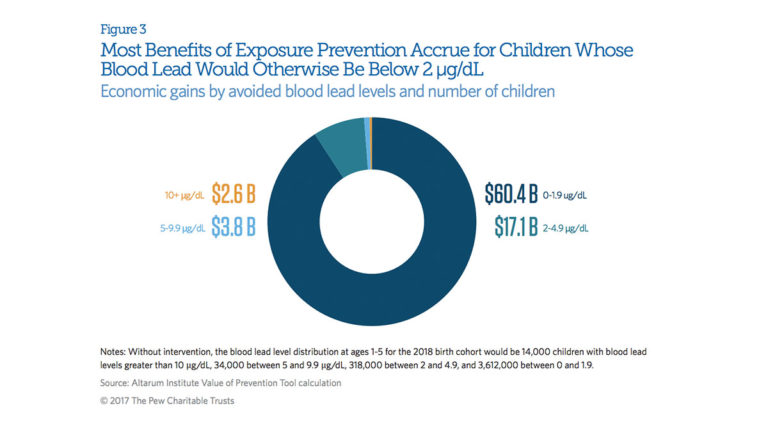Saving Money through Preventing Lead Exposure
Reducing early lead exposure in children would result in future savings: increased lifetime earnings, better health and outcomes, and better quality of life overall.

Read Time: 2 minutes
Published:
A recent report from Pew Charitable Trusts illustrated that while advances have been made in preventing lead exposure to children in the past half-decade, lead still poses a significant threat to the well-being of children. Between 2011 and 2014, the National Center for Health Statistics estimated that nearly 2 million children had a blood lead level greater than 2µg/dL. Research has found moderate to severe negative outcomes for blood lead levels at this level and above, which include impaired memory and executive function, decreased IQ, conduct disorder, attention disorders, and a number of other mental and behavioral health challenges.
To illustrate just one potential benefit of preventing lead in children’s blood, the report models the financial savings that would likely result from a zero level. The report states that the hypothetical lifetime savings would be about $84 billion just for babies born in 2018. The majority of the population (90.8%) will end up with levels between 0 and 1.9 µg/dL in their first 5 years of life. And because lead is detrimental to health and well-being even at such minimal levels, this is where the report finds the majority of possible savings. This means that it will take serious efforts and infrastructure changes to ensure even small traces of lead are removed from children’s environments.
The table below shows that potential savings would come from the potential for higher lifetime earnings, better health and outcomes, and better quality of life overall.

Photo via 10 Policies to Prevent and Respond to Childhood Lead Exposure. Health Impact Project.
The report points out, however, that federal guidelines limiting environmental lead do not reflect new research about the extent of the negative effects of lead. The Environmental Protection agency continues to ignore their own Science Advisory Board’s recommendations for updating standards related to air, dust, paint, soil, and water, to name a few. “The EPA’s soil lead standard is 400 parts per million (ppm) for areas where children play,” says the report, “while, by comparison, California’s guideline is 80 ppm.”
Ultimately, current environmental standards for what lead levels are considered ‘acceptable’ make preventing even minimal lead levels in children improbable, despite the immense biological and financial benefits that would likely result.
Databyte via 10 Policies to Prevent and Respond to Childhood Lead Exposure. Health Impact Project.



